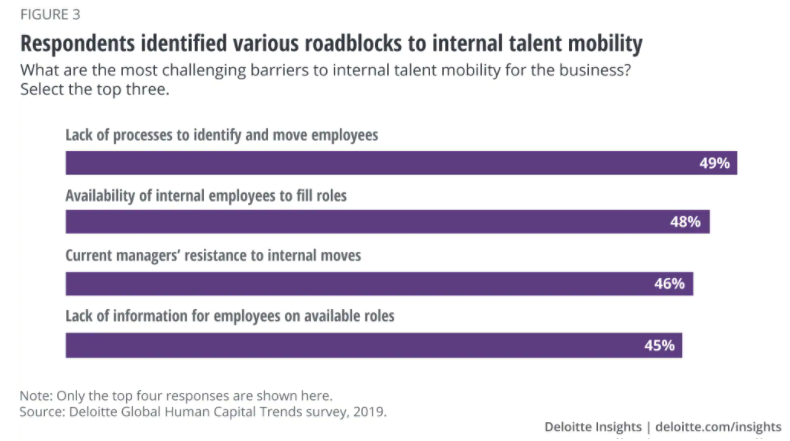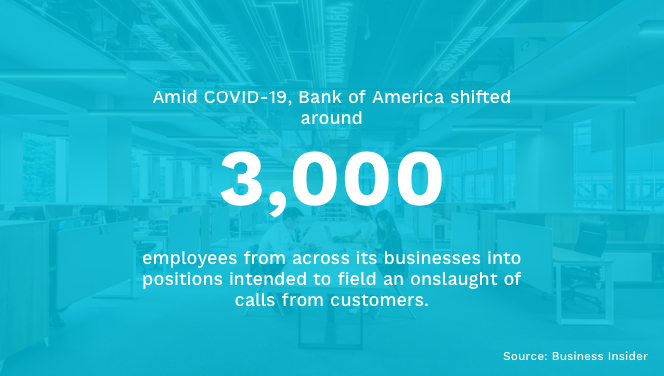The situation on the global labor market and in recruitment is changing rapidly due to the COVID-19 pandemic and the subsequent economic downturn. Many organizations have implemented hiring freezes and anticipate a decline in external hiring in the near future.
So right now, it is a great time to have a close look at the talent you already have on board to fill in the skills gaps and prioritize internal mobility at your organization.
Internal mobility is an essential part of recruiting and talent development. It allows a company to move its team internally to reskill, fill department gaps, and cross-collaborate to get a project done or hit an organizational goal. Of course, navigating internal mobility in a company is easier said than done. It requires a plan, program, and delivery—which is what this article is going to tackle.
Let’s get started.
What’s in?
Like what you see?
Don’t miss out. Subscribe to our quarterly digest to get the latest TA and TM resources delivered right to your inbox.
What is internal mobility?
Internal mobility is a term used to describe the movement of your employees to new, internal opportunities within your organization. It includes both vertical mobility, so usually an upward movement between job levels, and horizontal mobility, which describes moving within the same job level.
By encouraging your workforce to improve their skills and remain engaged in the company, you can then fill new positions internally as well as encourage senior staff to mentor new team members when they come on board.
Let’s put that definition into perspective.
When a company fills a job role, they may be hiring because a person possesses a particular skill set, like marketing, software engineering, or finance. But what about if that new team member had the skill set to move around internally and fill different job roles as required?
The employee may have been recruited as a human resources manager, but it doesn’t mean that they don’t want to upskill and move into another area of the company as time progresses. It’s in this type of situation where internal mobility can be a gamechanger.

3 out of 4
businesses have only developed basic internal mobility programs.
Source: Bersin
Without a thorough plan, it’s unlikely team members can take advantage of the benefits of internal mobility, like upskilling and transferring to other departments. A Deloitte survey found only 6% of companies believe they’re excelling at moving talent around internally.
59% of respondents answered that they were either doing a fair or inadequate job of making the most out of the talent they already had in their companies. The biggest reason, they said, was they lacked the processes to move that talent around internally:

Because of the lack of processes, the company is less likely to look at the talent it already has and be forced to look at hiring new staff to fill gaps. If your business has a more agile approach to internal mobility, however, you can hire someone who can do this current job, but also quickly move on to the next one when the time comes.
This can be especially beneficial in times when your organizational needs fluctuate due to the economic uncertainty, like amid the COVID-19 crisis.
How does internal mobility benefit your organization and your employees?
Unlocking the power of a team’s different skill sets can be a gamechanger for your company.
By promoting internal mobility in your team, you have the chance to change the culture of your approach to talent. If you have processes in place that alert you to internal talent, you can nurture career ambitions and improve retention rates among your team. Plus, you already know that your employees have the right culture fit to work for you.
In a way, internal mobility can help you to future-proof your workforce by nurturing your team’s skills and showing that you want them to develop within your company. This is especially true for today’s younger workforce. PwC’s Millennials at Work report found that the most attractive part of an employer was the possibility of career progression:

A further 35% said that companies that offered them excellent training and development programs were also attractive employers.
If we digest all of the positives for internal mobility so far, we can break it down into three main benefits:
- Retention: Developing your team skills and investing in their futures not only helps their career progressions but makes your company a more attractive employer
- Cross-collaboration: Having the ability to shift talent around internally allows you to fill skill gaps and stops the need to look outside to do so
- Engagement: If you offer your team members further training and development, it can keep them engaged and invested in the company
Now that you know how valuable internal mobility is—let’s break down how to put a process in place in your own company.
8 best practices for internal mobility
1. Building a culture of internal mobility
Creating a culture of skill sharing and development within your organization is the first step to creating an internal mobility process.
According to LinkedIn’s Workforce Learning Report, 94% of employees will stay at a company if they believe it is invested in their careers. By creating a continuous learning environment where team members can grow, you’re giving a clear signal that you are invested in that growth.
Beyond retention, creating a culture where moving around to a different job within the same company is encouraged will also benefit your business. Not only will employees be in charge of their own career trajectory, but they can also grow into company mentors to help with other team members who are looking to broaden their skillsets.
2. Auditing the skills you have on board
You may have a hundred, a thousand or even more people at your company—but do you know what skill sets they have?
Internal mobility is only truly possible if you know what each employee is capable of. Auditing each team member, preferably during the hiring stage, will enable you to track what skills each department has, and what gaps your company has.
For example, if you bring on a new hire in your marketing department who also has public relations skills, this should be kept on their file. In the future, if a job becomes vacant on your public relations team and the hire wants to fill it, this not only saves you from hiring externally but it also helps retain that team member by keeping them happy. Similarly, if there is a PR project you need help with, you can easily reach out to your employee to ask for assistance.
Which brings us to the next point.
3. Supporting cross-functional projects
Conducting a skills audit during your hiring process makes it easier for your team to cross-collaborate on projects.
Utilizing internal mobility doesn’t only mean moving one team member from one department to another permanently. It also gives you the freedom to use those mixed skill sets so your team can join forces to make a project even stronger.
For example, if the staff on your design team have shown interest in a marketing project—encourage them to voice their ideas. Not only will it promote sharing ideas and spark innovation, but it will show that you are open to internal mobility and shuffling talent around.
Stop guessing,
Start data-driven hiring.
Learn how you implement a modern candidate selection process, that is: streamlined, experience-driven and backed by data.

4. Empowering managers
Creating a culture of internal mobility is largely a responsibility of your management team.
You need to educate your managers on how to spot ambitious employees and nurture and encourage them to develop their skills. Ideally, your management team will make an outward effort to uncover what their team’s career progression goals are, and find ways to support them to build on those goals internally.
By finding and nurturing team members who have aspirations beyond the role they were hired for, managers have a unique opportunity to foster company loyalty. If a manager can identify a team member who wants to move up the career ladder, they can then point them in the right direction of internal training and learning opportunities. Ultimately, managers can then use these upskilled employees to fill internal positions once they become vacant.
5. Creating an internal talent marketplace
Whenever we have a vacant position to fill, usually we start by using external recruitment channels like job boards or social media to hire the right person for the job.
But what if the right person already exists within the company?
Creating a system to connect employees to inner opportunities is key to a successful internal mobility system. This step starts with auditing new team members’ during the hiring process by keeping a skills database. Then, each time there is a cross-collaboration opportunity or a job vacancy, the department manager can refer to the talent marketplace to see if there’s anybody already employed at the company whose skills fit.

Bank of America was able to quickly reshuffle their workforce to deal with an unexpected business challenge.
6. Putting mentorship and coaching programs in place
Employees are looking for more out of a company than just a paycheck.
They want to develop their skills and be shown a clear path to career progression. It makes sense that you have programs and systems in place to make sure you meet those needs. For example, a Deloitte study found millennials who want to stay with a company for at least five years were likely to have a mentor which directly links to their professional development.
One clear message from the report? Mentorship is key to retaining talent. The positive impact of mentoring on staff also filters throughout a business. Because mentoring and coaching programs encourage employees to become more engaged, it also makes them feel valued and ultimately helps companies to retain their most loyal talent.
7. Having a structured internal recruitment process
Encouraging mentorships and career development will only benefit your company if you have a structured internal recruitment process in place. Without it, it’s hard to audit skills, develop talent, and link employees to new opportunities.
You can start by setting up regular meetings with your recruitment team and other departments. These meetings can help identify skill gaps and department needs before they become problematic. After all, how will you know what they need if you don’t discuss these requirements with them?
Then, think about how your existing employees can learn about relevant job openings at your organization. Do they need to keep an eye on your career page or do you maybe have an intranet page with positions you’re looking to fill? How can they apply if they are interested in changing roles?
As we’ve already mentioned, it is beneficial to have every team member’s skill set on a file. You can then filter your current staff whenever a job vacancy hits. If there is someone internally who can fill the position, you can easily reach out and ask if they’re interested in a new role.
Consider how the internal recruitment process will differ from the external one. For example, you can skip a culture fit assessment, as you already know they’re a fit. On the other hand, you still want to verify if they can indeed perform well in the new role, so a work assignment is useful to include.
Having a structured internal recruitment process will not only make filling the open positions faster but also help your employees be more confident about making career moves within the company, as they know what awaits them.
8. Spend time on succession planning
Finally, put in place a succession plan so you have a clear idea of what will happen if an employee leaves their position.
As Harvard Business Review bleakly highlights, all CEOs will inevitably leave office, yet research shows most organizations are ill-prepared to replace them. However, a CIPHR study found that although 92% of companies admitted it was a risk to not have a succession plan in place, only 25% felt they had the right candidates to fill vacant positions. To fill the void, you can look within your current talent pool, or hire externally.
Although internal candidates are unlikely to possess the skills of a CEO, they will have unique advantages that external candidates don’t. For example, they’ll have a deep understanding of company culture, processes, and most importantly, relationships with other team members.
For an internal succession plan to work, the role you’re filling needs to have a clear path to transition from the old employee to the new. For example, the outgoing employee may spend time teaching the team member who will fill their position, or your company may invest in an internal training course which will help them refine their skills and prepare them for their new role.
Either way, having a succession plan in place is crucial if you want to enable internal mobility at your company.
Wrapping up
Internal mobility means so much more than just filling vacant job roles in a company from within.
On the contrary, a well-built internal mobility program can help you hire better, develop your talent, share skills and retain your staff. At its core, internal mobility focuses on creating an organization that promotes inclusive company culture, encourages career progression, and builds team relationships through mentoring.
It will also help you deal with shifting talent needs within your organization in an uncertain business period, just like during the sudden economic slowdown of 2020.
Yet, the big winner here will be the staff you invest in. By showing them that you want them to have a successful career and reach their goals they’ll not only be happier—but they’re more likely to stay with your company for many years in the future.
Stop guessing,
Start data-driven hiring.
Learn how you implement a modern candidate selection process, that is: streamlined, experience-driven and backed by data.



